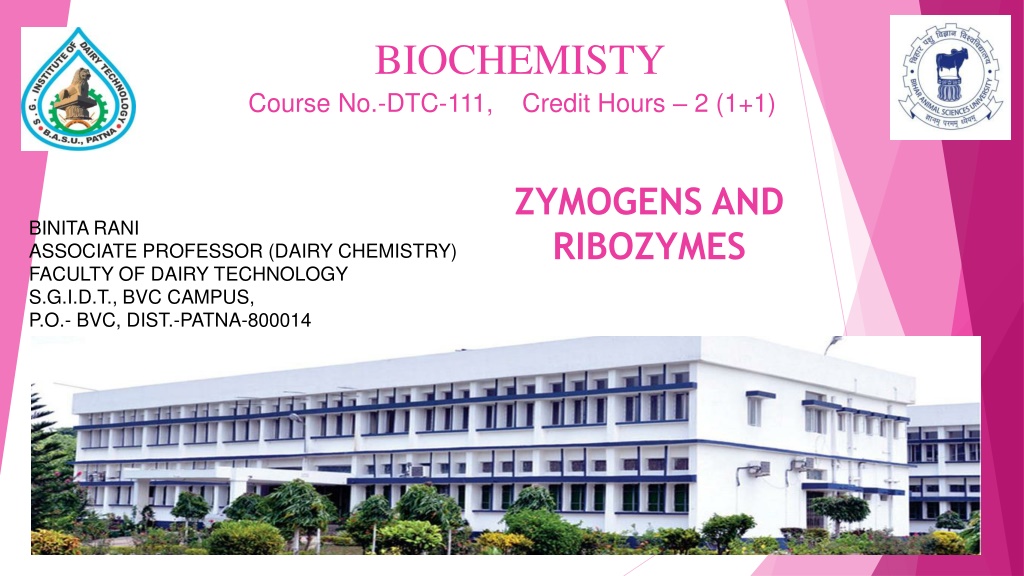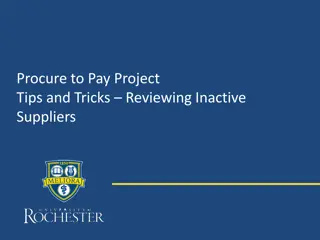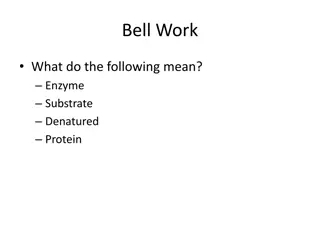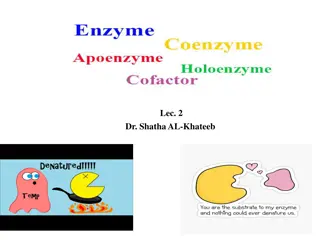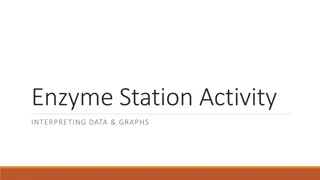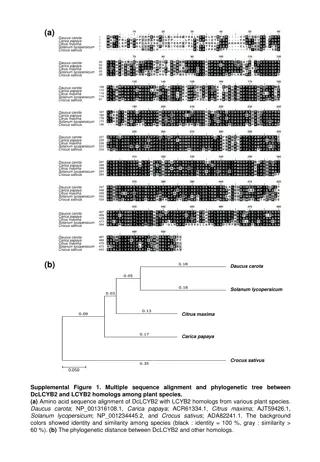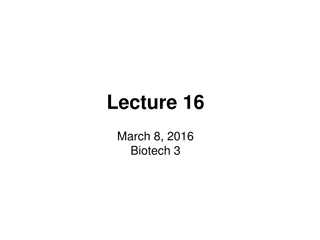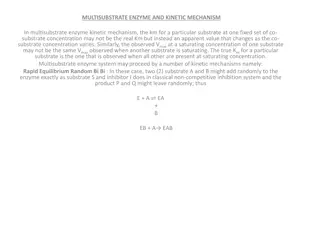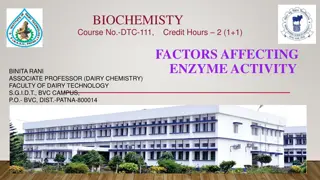Zymogens and Ribozymes: An Overview of Inactive Enzyme Precursors
Zymogens, such as trypsinogen and pepsinogen, are inactive enzyme precursors that are activated through specific cleavage in various biological environments. Understanding the activation process of zymogens sheds light on how enzymes are regulated and function in the body.
Download Presentation

Please find below an Image/Link to download the presentation.
The content on the website is provided AS IS for your information and personal use only. It may not be sold, licensed, or shared on other websites without obtaining consent from the author. Download presentation by click this link. If you encounter any issues during the download, it is possible that the publisher has removed the file from their server.
E N D
Presentation Transcript
BIOCHEMISTY Course No.-DTC-111, Credit Hours 2 (1+1) ZYMOGENS AND RIBOZYMES BINITA RANI ASSOCIATE PROFESSOR (DAIRY CHEMISTRY) FACULTY OF DAIRY TECHNOLOGY S.G.I.D.T., BVC CAMPUS, P.O.- BVC, DIST.-PATNA-800014
Zymogens Several enzymes are synthesised as larger inactive precursor forms => proenzymes or zymogens. Activation of zymogens involves => irreversible hydrolysis of => one or more peptide bonds. The biochemical change usually occurs in a lysosome where => a specific part of the precursor enzyme is => cleaved in order to activate it.
amino acid chain that is released upon activation is => called activation peptide. pancreas secretes zymogens partly => to prevent the enzymes from digesting proteins in the cells in which they are synthesized. Fungi also secrete digestive enzymes into => environment as zymogens. external environment has a different pH than inside the fungal cell and => this changes => zymogen's structure into an active enzyme.
Digestive Enzymes as Zymogens Digestive enzymes trypsin, chymotrypsin and elastase => produced as zymogens in => pancreas. They are transported to => small intestine as their zymogen forms and => activated there by => cleavage of specific peptide bonds. Trypsin is synthesized initially as => zymogen trypsinogen.
It is cleaved (and hence activated) in => intestine by => enzyme enteropeptidase which is only produced in the intestine. Once activated trypsin can => cleave and activate further trysinogen molecules as well as other zymogens => such as chymotrysinogen and proelastases. The peptidase in the stomach is pepsin => works optimally in the acidic environment of the stomach => being active at pH 2-3 but => becoming inactivated when the pH is above 5.
The chief cells at the base of the gastric glands secrete => zymogen => called pepsinogen. Pepsinogen is partially hydrocholoric acid (HCl) => which is secreted by the parietal cells. activated by => This partially active enzyme => cleaves the peptide from other pepsinogen molecules to => form active pepsin.
Biological Significance of Zymogens Zymogens : Inactive Precursor Proteins. A clinically important mechanism of controlling enzyme activity is => the case of protease enzymes involved (predominantly) in => food digestion and blood clotting.
Activation of zymogens by proteolytic cleavage result in => irreversible activation Zymogen forms allow proteins to be transported or stored in => inactive forms that can be readily converted to => active forms in response to some type of cellular signal.
Thus they represent a mechanism whereby => the levels of an enzyme/protein can be rapidly increased (post- translationally). Other examples of zymogens include => proinsulin, procollagen and many blood clotting enzymes.
Ribozymes Before the discovery of ribozymes => enzymes, which are defined as catalytic proteins were => only known biological catalysts. First ribozymes were discovered in 1980s by => Thomas R. Cech => who was studying RNA splicing in the ciliated protozoan Tetrahymena thermophila and Sidney Altman => who was working on the bacterial RNase P complex.
These ribozymes were found in => intron of an RNA transcript => which removed itself from the transcript, as well as in the RNA component of the RNase P complex => which is involved in the maturation of pre-tRNAs. Ribozymes often have divalent metal ions such as Mg2+ as cofactors.
A ribozyme (from ribonucleic acid enzyme => also called RNA enzyme or catalytic RNA) is => an RNA molecule that catalyzes a chemical reaction. Many natural ribozymes catalyze => either hydrolysis of one of their own phosphodiester bonds => or hydrolysis of bonds in other RNAs. They have also been found to catalyze => aminotransferase activity of the ribosome.
Investigators studying the origin of life have produced ribozymes in the laboratory => that are capable of => catalyzing their own synthesis under very specific conditions => such as an RNA polymerase ribozyme. Some ribozymes may play an important role as => therapeutic agents => as enzymes which tailor defined RNA sequences, as biosensors, and => for applications in functional genomics and gene discovery.
Activity Although most ribozymes are quite rare in the cell => their roles are sometimes essential to life. For example => functional part of the ribosome => the molecular machine that => translates RNA into proteins => is fundamentally a ribozyme => composed of RNA tertiary structural motifs => that are often coordinated to metal ions such as Mg2+ as cofactors. There is no requirement for => divalent cations in a five- nucleotide RNA that can catalyze => trans-phenylalanation of a four-nucleotide substrate => which has three base complementary sequence with the catalyst.
